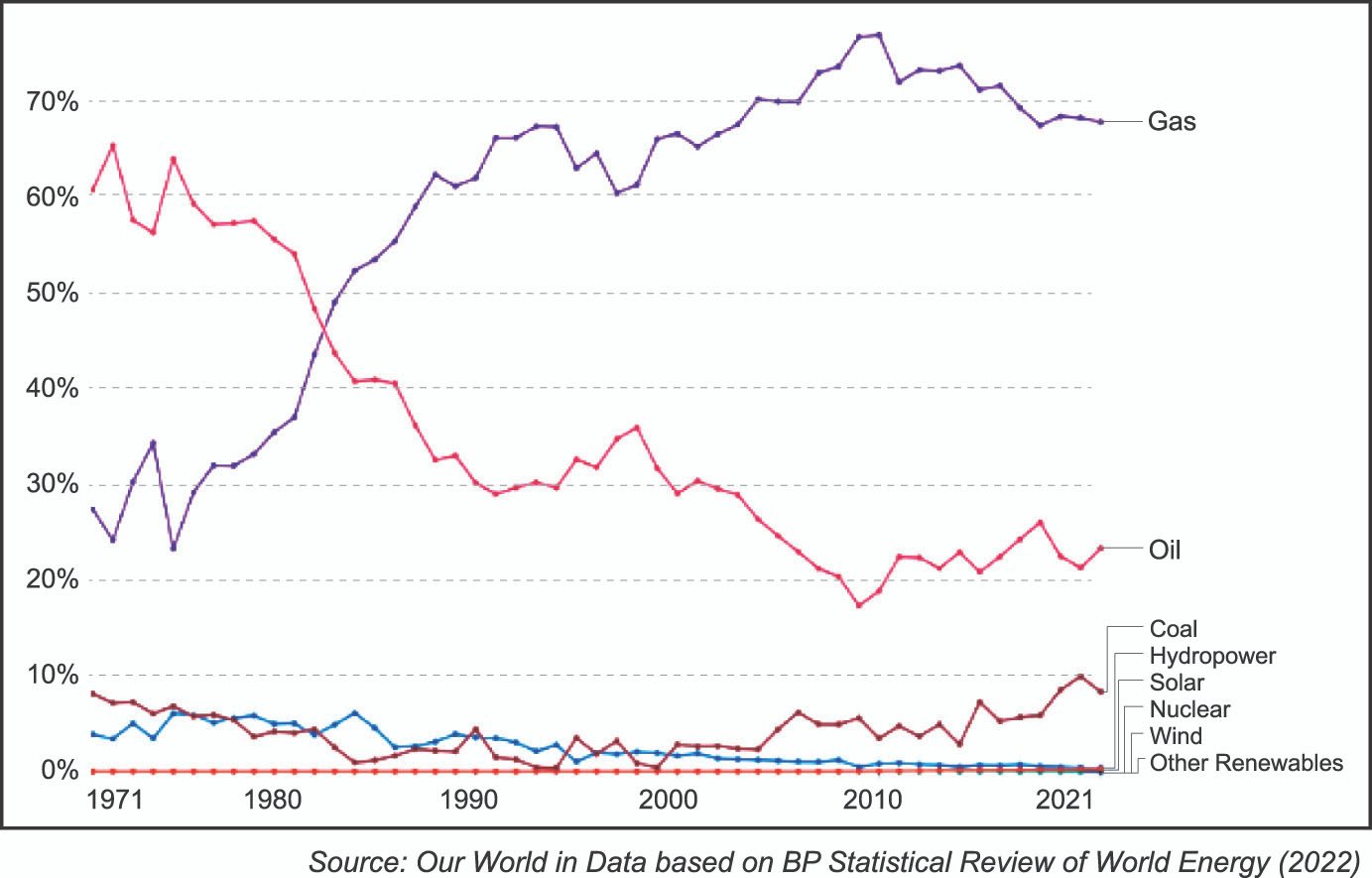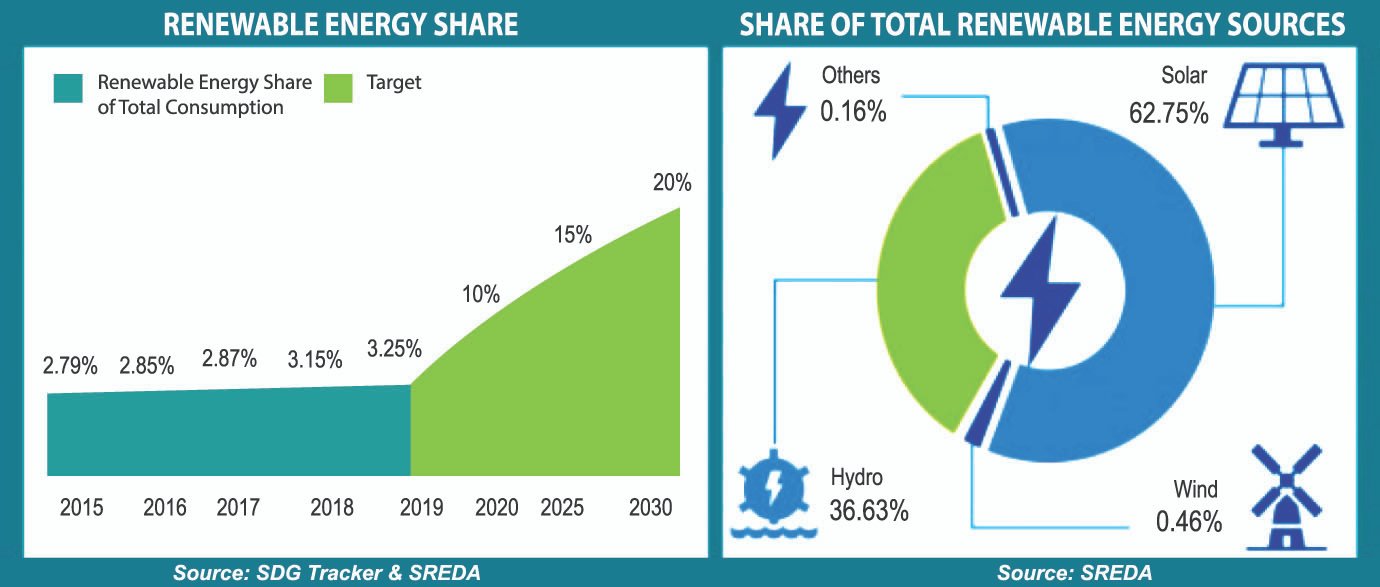
Current Scenario
Bangladesh stands at a pivotal moment in its energy journey, emerging from the recent power crisis with a renewed focus on building a resilient, sustainable energy sector. The nation has set an ambitious target: by 2040, it aims to generate 40% of its electricity from renewable sources, a crucial step toward a cleaner energy landscape that aligns with its economic and environmental goals.[1] Yet, the road to this transition is complex, requiring a careful balance between bolstering renewables and securing reliable energy through long-term LNG contracts.
The challenges are substantial, given Bangladesh’s rapid urbanization and industrial expansion. With near-universal electrification achieved, the country’s energy needs are intensifying, particularly in sectors like ready-made garments, which contribute over 10% of the GDP and nearly 80% of exports.[2] This scenario underscores the need to diversify Bangladesh’s energy mix, moving away from the nearly 99% fossil fuel dependency recorded in 2021. At that time, natural gas supplied about 67% of the country's energy needs, with imported LNG accounting for 26% of this figure.[3]

Bangladesh’s shift from a largely domestic, fossil fuel-driven energy framework to a diversified mix that includes renewables like solar and wind is an opportunity to strengthen energy security and economic independence. Today, solar power leads Bangladesh's renewable energy transition, with an installed capacity of 1,084.552 MWp[4], making it the country's most promising renewable energy source. Ongoing projects continue to expand this capacity, furthering solar role in the energy mix. By strategically investing in renewable energy infrastructure and scaling up solar and wind installations, Bangladesh aims to build a resilient energy grid that not only meets the demands of its growing population but also aligns with global sustainability goals.
Energy Landscape and Renewable Energy Development
Bangladesh holds significant potential for renewable energy development, with solar, wind, and biomass resources offering promising prospects. The government has set ambitious targets to achieve 40% of its energy generation from renewable sources by 2041, a goal that is essential given the country's rapidly growing energy demands and the need to reduce dependence on fossil fuels. Currently, solar power contributes approximately 4.5% to the total installed capacity, generating around 1,183 MW from various projects. With an estimated potential of 50,174 MW, solar energy could meet nearly 80% of Bangladesh's projected energy demand by 2041. The draft National Solar Energy Action Plan aims for around 41 GW of solar power by that year.
Wind energy also presents a substantial opportunity, particularly in Bangladesh's coastal regions, which offer favorable conditions for wind power generation. The potential wind capacity is estimated to be as high as 30,000 MW, with average wind speeds ranging from 5 to 8 m/s—ideal for turbine operation. Additionally, biomass remains a viable option for renewable energy, though its expansion is limited by competing demands for agricultural waste. Innovations such as bio-gasification could improve biomass utilization while ensuring sustainability.
As of the end of 2024, Bangladesh's total installed power capacity exceeded 28 GW, which included nearly 6 GW of oil-fired, 7 GW from coal, import 1.1 GW, and 12 GW of gas-fired power. Renewable energy remained marginal, with only 230 MW from hydropower and 663 MW from solar and wind. However, by 2022, renewable capacity had surpassed 950 MW.

The country aims to provide universal electricity access, and as of 2020, approximately 99% of the population has access to electricity, with 100% achieved by 2021. However, around 40% still lack reliable electricity access, particularly in rural areas.The government also emphasizes incorporating RE in the agricultural sector, with a target to install 10,000 solar irrigation pumps by 2027 to support sustainable agriculture practices. Around 1,515 solar pumps with a total capacity of 40 MWp are operational.
Despite these plans, current renewable energy targets fall short of their potential. The Integrated Energy and Power Master Plan from 2023 outlines a goal of 18% clean energy by 2030 and 40% by 2041. While these figures may seem ambitious, they include new technologies such as carbon capture and storage (CCS), ammonia, and hydrogen which, despite being fossil fuel-based, are counted within the clean energy targets. In reality, only 5.7% of the 18% clean energy target by 2030 will come from renewables, rising to 8.8% of the 40% target by 2041. Currently, renewables make up just 2% of the national energy mix.
To meet its solar targets, Bangladesh plans to deploy the following:
-
16 GW through solar hubs
-
4 GW via electric utilities
-
5 GW by private developers
-
2.5 GW for irrigation pumps
-
12 GW from rooftop installations

Challenges of Renewable Energy Transition
However, scaling up solar energy through the installation of grid-connected solar plants faces several challenges, particularly the scarcity of land. Although Bangladesh’s tropical climate is suitable for solar, large-scale installations are hampered by limited available land. Agricultural land is prioritized for food production, and strict regulations prohibit its use for solar projects, complicating the identification of suitable sites due to fragmentation and competing land needs. Even when viable locations are found, land acquisition can be delayed by disputes and bureaucratic hurdles.
Furthermore, establishing solar power plants requires navigating a complex regulatory environment, involving up to 38 different licenses and certificates. This cumbersome process can discourage investors which involves slow project implementation. Financing solar projects is also challenging, as the initial investment is substantial, and local financial institutions often do not offer favorable terms.
Integrating solar energy into the existing grid poses additional difficulties. The national power grid struggles with frequent outages and voltage fluctuations, which complicates the incorporation of intermittent solar power. Additionally, solar energy production varies due to changes in sunlight throughout the day and across seasons, necessitating advanced grid management and energy storage solutions to ensure a reliable power supply.
The challenges of establishing large-scale solar plants in Bangladesh have led to promote rooftop solar installations as a viable alternative for renewable energy transition. This strategy leverages the abundant rooftop space available in urban and industrial areas, addressing land scarcity while contributing to the country’s renewable energy goals. Rooftops of residential, commercial, and industrial buildings can be utilized without requiring additional land, making it an efficient use of space in a densely populated country. The government has introduced a net metering system, allowing users to connect their rooftop solar systems to the national grid. This enables them to sell excess power back to the grid, providing financial incentives and reducing overall electricity costs. The rapid installation of rooftop solar systems could significantly reduce carbon emissions. For instance, installing 2,000 MW of rooftop solar within 2030 could potentially decrease CO2 emissions by about 15 million tonnes. Supporting Bangladesh's Nationally Determined Contributions (NDCs) under international climate agreements.
Grameen Shakti and Renewable Energy
Grameen Shakti, founded by Nobel laureate Professor Muhammad Yunus, is a leading Social Business entity dedicated to improving "Access to Energy" for rural communities in Bangladesh. Having installed over 1.7 million Solar Home Systems (SHS), Grameen Shakti has provided electricity to more than 7 million people, transforming livelihoods, education, healthcare, and income generation in remote areas. Since venturing into the rooftop solar sector in 2017, the organization has installed over 800 projects across the country, utilizing underutilized spaces to provide cost-effective, low-maintenance energy solutions. The installations have helped reduce over 11,500 metric tons of carbon emissions. These efforts have enabled small businesses to operate longer, boosted agricultural productivity through solar-powered irrigation, and improved educational outcomes by giving students and schools access to electricity. In healthcare, rural clinics have been equipped with solar-powered equipment, ensuring essential services like vaccine refrigeration. By fostering green growth, creating jobs, and driving income generation.
Grameen Shakti's innovative solutions continue to address climate change and sustainability challenges. Committed to "sustainable energy at an affordable cost," the organization partners with various stakeholders to expand its social footprint, transforming lives and advancing Bangladesh's journey toward a just energy transition. The instances of such innovative empirical projects are:
Ø Peer-to-Peer Energy Trading Project: In partnership with ME SOLshare, Grameen Shakti won the United Nations DESA’s Powering the Future We Want initiative in 2017 for the project Smart Peer-to-Peer Solar Grids for Rural Electrification & Empowerment. As project implementor, Grameen Shakti managed field activities, installing 100 SMART grids, benefiting 15,000 individuals, and introducing peer-to-peer energy trading to support a sustainable, scalable model for Bangladesh and beyond. The project also piloted productive use appliances (EV charging stations, egg incubators, rice hullers), maximizing energy use and generating additional community income.
Ø Eco-Village Development Project: “Eco-village Development” or EVD is an integrated socio-economic development concept, in which existing villages are taken as the smallest unit for integrated climate action through the introduction of Renewable Energy solutions. This is a multi-country, Danish-funded project, comprising four South Asian countries--Bangladesh, India, Nepal & Sri Lanka. EVD is the brainchild of the International Network for Sustainable Energy (INFORSE), a non-profit organization based in Denmark. Grameen Shakti is the Country Focal Point of the International Network for Sustainable Energy (INFORSE), as well as one of the Founders of the INFORSE-South Asian Chapter.
Ø USAID-Supported Project: Maximizing Solar Irrigation Efficiency for Economic and Environmental Impact: This project transforms solar-powered irrigation in Bangladesh by integrating productive use appliances (PUA) and a net metering facility, maximizing clean energy use while reducing reliance on diesel. Through the strategic use of excess energy for crop processing (e.g., rice milling, spice grinding) and feeding surplus power to the grid, the project ensures solar systems remain active year-round, boosting irrigation coverage during peak seasons.
Outcomes from this project include enhanced agricultural productivity, job creation, and economic growth in Kurigram. By increasing solar system utilization, the project promotes sustainable, low-carbon agriculture while preserving over 0.83 million tonnes of CO₂ emissions annually, demonstrating a scalable model for renewable energy’s role in rural development.
Just Energy Transition
A just energy transition refers to the process of shifting from fossil fuel-based energy systems to renewable energy sources in a manner that is fair, inclusive, and equitable for all stakeholders involved. It emphasizes:
· Social Equity: Ensuring that the benefits and costs of the transition are distributed fairly, particularly for marginalized and vulnerable communities.
· Decent Work Opportunities: Creating sustainable jobs in the renewable energy sector while protecting the livelihoods of those affected by the transition away from fossil fuels.
· Community Engagement: Involving local communities in decision-making processes to ensure their needs and voices are prioritized.
· Environmental Sustainability: Promoting clean, resilient energy systems that contribute to climate goals without exacerbating social inequalities.
Bangladesh’s Path Toward a Just Energy Transition
Bangladesh is making a sincere effort to take a stride toward a just energy transition, emphasizing climate resilience, sustainable energy development, and inclusivity in its policies and initiatives. This shift toward clean energy is not only addressing the country’s rising energy demands but also creating new opportunities for sustainable economic growth and gender equality.
Employment Growth in the Clean Energy Sector
Bangladesh’s clean energy transition is creating sustainable employment opportunities. From 2011 to 2016, the solar sector experienced an annual job growth rate of 18.5%[5], significantly outpacing the national average of 1.9%. The workforce expanded from 60,000 to 140,000 during this period, showcasing the sector’s potential for generating sustainable livelihoods. The expansion of renewable energy projects is likely to continue driving job creation as the country scales its clean energy capacity.
Gender Inclusion in the Energy Sector
Women’s inclusion in the energy sector is one of the critical components to ensuring a just transition. In Bangladesh, women make up only 10% of the energy workforce, compared to the global average of 32% in the renewable energy sector. Closing this gender gap is essential for achieving a more equitable transition. Studies, such as one by McKinsey & Company, have shown that companies with greater gender diversity on executive teams are 21% more likely to experience above-average profitability. This underscores the economic benefits of including women in decision-making roles within the energy industry, apart from ensuring equitable participation by women.
Grameen Shakti's Role in Just Transition
Grameen Shakti actively considers incorporating the components of Just Transition in all of its projects. It is working to bridge the gender gap through initiatives such as capacity-building training under the WePOWER project. WePOWER refers to incorporating Women in Power Sector Network - a forum to promote and diversify female practitioners’ opportunities in the power and energy sector. The objectives of WePOWER are to support workforce participation of women in energy projects and institutions and promote normative change regarding women through its five pillars of STEM – Education, Recruitment, Professional Development, Retention, and Policy and Institutional Change. It has trained around 100 women annually, focusing on renewable energy knowledge and technical skills. These programs not only enhance women's understanding of clean energy technologies but also empower them to become technicians capable of independently addressing electrical issues in their communities. Grameen Shakti’s training of female technicians and other capacity-building programs are vital steps toward increasing the installation of SHS and promoting the acceptance of clean energy solutions at the household level.
While installing SHSs, Grameen Shakti established the Grameen Technology Center (GTC) which was completely operated and managed by women. The center used to produce and repair small electronics, as well as to train the village women as technicians to service the installed SHSs. The aim was to involve women in the Renewable Energy Sector and the process to empower rural women through job creation as women technicians and ensure faster after-sales service to the customer.
Apart from the above, in collaboration with the Centre for Entrepreneurship Development (CED) at Brac University, Grameen Shakti played a pivotal role in developing materials for an online training program focusing on Decentralized Solar Solutions. This initiative was part of the project titled “EmPower: Women for Climate Resilient Societies,” jointly implemented by the UN Environment Programme (UNEP) and UN Women. The objective was to enhance women's participation in the renewable energy sector across Bangladesh, Vietnam, and Cambodia. Targeting women students in technical departments and those interested in energy entrepreneurship, nearly 300 participants from the aforementioned countries underwent training facilitated by BRAC University and UNEP.
Another significant ongoing program to promote the just energy transition is the collaboration of Grameen Shakti with the University of Melbourne to provide training to the utilities in South Asia. The project is funded by the Asian Development Bank (ADB). The project will present key data on just energy transition to policymakers and energy experts across the region, fostering informed decisions that support equitable and sustainable energy development in South Asia.
The Path Forward
To fully achieve a just energy transition, Bangladesh must address several key areas:
-
Scaling Renewable Energy Projects: Expanding solar, wind, and other renewable energy capacities to ensure a more balanced energy mix.
-
Grid Modernization: Upgrading infrastructure to accommodate the increased integration of decentralized and renewable energy sources.
-
Gender Inclusion: Increasing women's participation in the energy workforce and leadership positions through targeted training, financing, and policy support.
-
Policy Alignment and Financing: Utilizing existing funds and creating new financial mechanisms to support small and medium-sized renewable energy projects, particularly for women entrepreneurs.
-
Decent Work Opportunities and Community Engagement: Investing in renewable energy creates opportunities for quality jobs in project development, operation, and maintenance. By engaging local communities in energy initiatives, Bangladesh can ensure that the transition to renewable energy not only creates jobs but also empowers individuals and strengthens community bonds.
-
Environmental Sustainability: Keeping environmental sustainability at the core of energy projects will reduce emissions, minimize ecological impact, and align with global climate commitments. Sustainable practices in project design and implementation will protect natural resources and support the country’s climate resilience efforts.
Bangladesh's journey towards a just energy transition reflects its commitment to a sustainable, resilient, and equitable future. By focusing on scaling renewable projects, upgrading infrastructure, and prioritizing gender inclusion and community engagement, Bangladesh is setting the stage for a clean energy pathway that serves all its people. Supporting women’s participation in the energy sector and creating decent, sustainable job opportunities are key pillars in this approach, alongside financing mechanisms that enable a broader range of stakeholders to invest in clean energy solutions.
With the integration of social equity, environmental sustainability, and inclusive policy frameworks, Bangladesh is demonstrating that a transition to renewable energy can not only meet the nation’s growing energy demands but also enhance economic opportunities and empower communities. As the country continues to scale its initiatives and policies to overcome existing challenges, it moves closer to a future where clean energy is accessible, reliable, and beneficial for all. This vision for a just energy transition will ultimately support Bangladesh’s goals of universal electricity access, climate resilience, and inclusive economic development.
Download COP29 Special As PDF/userfiles/EP_22_10_COP29 Sohel Ahmed.pdf
Sohel Ahmed, Managing Director, Grameen Shakti; Kashfia Zaman, Assistant Project Manager, Grameen Shakti



